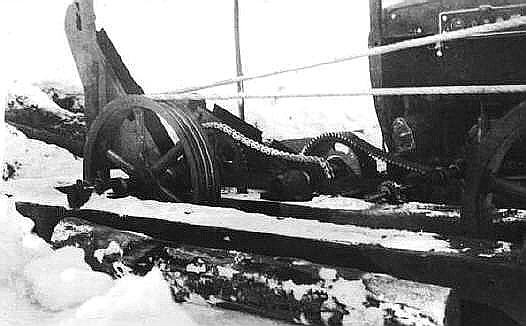The engine was
placed at the bottom of the tow line. This created a constant tension on the
downside of the rope. To create and maintain this tension, numerous
additional pulleys were required to the base tower.

FIRST TOW ADDED
1937 SEASON
|
After making a presence in the winter of 1936, the Simpson brothers pooled their resources, skills and talents. The family tannery business introduced them to several ideas that could be indirectly used to create their dreams on Romer Mountain. Mickey was responsible for the operation of the plant and took ideas used there and transferred them to the design of the tows. From the mind's eye, without a blueprint, they erected and aligned towers with tire wheels, acting as sheaves. This would create the "flow of the rope" which skiers held to bring them uphill. A car engine powered the movement of the rope. Since at the time built, testing this contraption was impossible, the brothers awaited the first snowfall with great anticipation. |
|
The engine was
placed at the bottom of the tow line. This created a constant tension on the
downside of the rope. To create and maintain this tension, numerous |
|
|
|
To conform to the edge of the cleared slope, the tow line bent to the right. This created difficulties about halfway up. |
|
Near the halfway
point, skiers were
required to let go of the rope. Several set of poles |
|
|
|
The Simpson brothers soon realized something had to change. They determined the elements necessary for a safe and efficient uphill transport. 1) The tow line had to be straight. 2) A three strand rope had to be used to fit in the hand. 3) The tow motor had to be placed at the top to reduce the downside tension. 4) Adjustment of the "cant" to the sheaves was needed to lessen the twist of the rope. 5) A sound method of stopping the engine in the case of an accident.
|